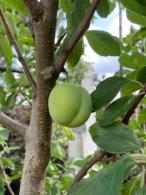Get Additional 5% Off 1st Order
Prunus Domestica Stanley Fruiting Plum Tree
A hardy variety that fruits reliably even in cold spots.
1. Add items to basket
2. Go to the basket
3. Enter your postcode in Delivery Price Check
Plant shape: Full standard
Trunk height: 1.6-1.8 m
Trunk girth: 8-10 cm
Rootball - supplied without a pot
Plant ID: 14989 100
To check delivery cost add your plants to basket, then you can type your postcode in our Quick Delivery Price Check.

Prunus Domestica Stanley is a deciduous self-fertile plum tree with sweet tasty plums that ripen in early autumn. It’s a great choice for kitchen gardens and mixed borders.
Stanley Plum was developed in Geneva in 1926 by Richard Wellington and was an immediate success because its ripe fruit is sweet and it is well suited to drying, jams and jellies. Stanley Plum is one of the most widely grown plum trees in the UK. This fruit tree has a spreading canopy of bright green leaves that follow its pretty, sweetly-scented white spring blossom. Its flowers are so popular with bees that it holds the RHS plants for pollinators badge. This plum tree is a heavy cropper. Abundant juicy blue plums with greenish flesh ripen in late summer or early autumn.
Plum Stanley is a reliable plum tree that’s stood the test of time in UK gardens.
Height and Spread of Prunus Domestica Stanley
Plum Stanley’s maximum height and spread is 2.5 to 4 metres after 5-10 years.
How Hardy is Prunus Domestica Stanley
This is a hardy plum tree that tolerates severe winters and sub-zero temperatures if it’s grown in full sun and well-drained soil.
How To Use Prunus Domestica Stanley
Plum Stanley is an excellent choice for fruit and vegetable gardens. It’s self-fertile but does better with a pollinating partner. It’s a good pollinating partner for other fruit trees too.
Aside from its outstanding plums, Plum Stanley’s is also an attractive ornamental tree. Its handsome wine goblet branches and attractive green canopy of leaves from spring to autumn boost a mixed border.
Because it only reaches 2.5 to 4 metres, Plum Stanley is suitable for sun-trap urban town gardens as well as larger spaces.
How To Care For Prunus Domestica Stanley
Plant Stanley Plum in full sun with fertile well-drained soil and avoid frost pockets. To ensure the blossom stays on the tree long enough to attract pollinators, shelter from wind is necessary.
Put lots of well-rotted organic matter in the planting hole and top it up with organic mulch every spring. Be sure to water it well until you see new growth and give it water in hot dry spells when the fruits are swelling.
Unlike apple trees, plums need pruning in late spring to avoid disease. Cut back branches by around 1/3 and trim excess growth to create a wine goblet shape. Remove any dead or damaged branches or suckers too.











